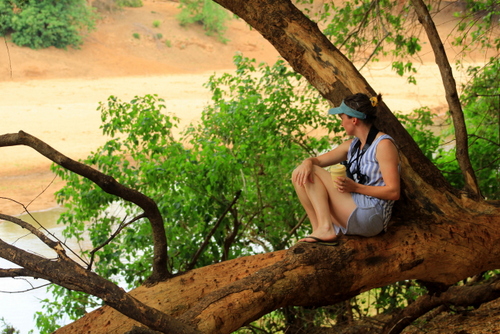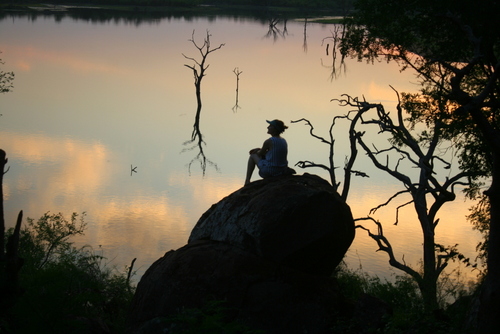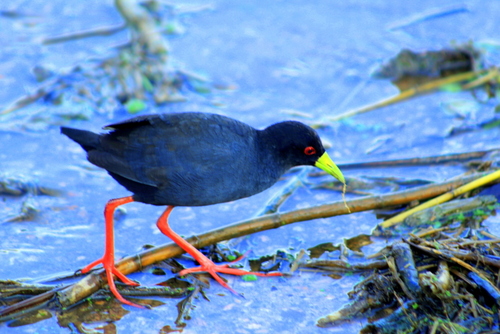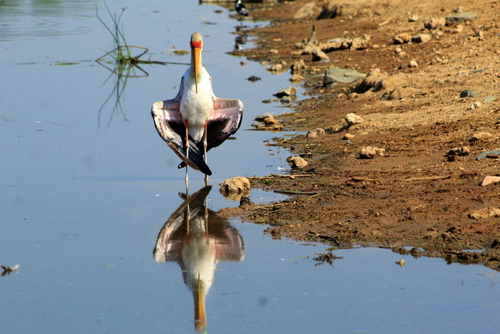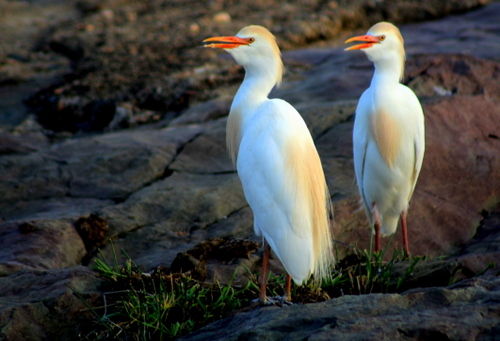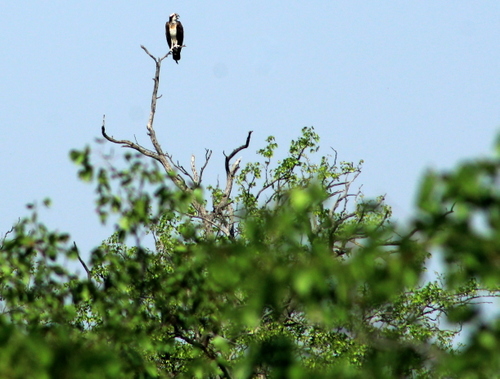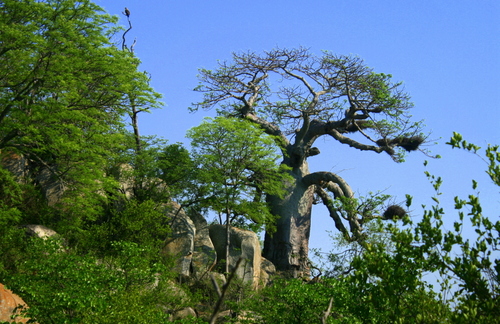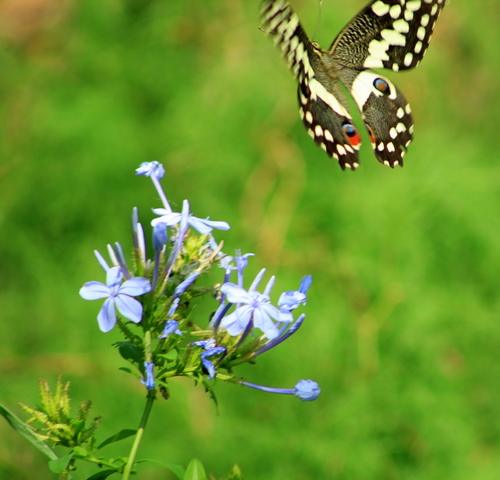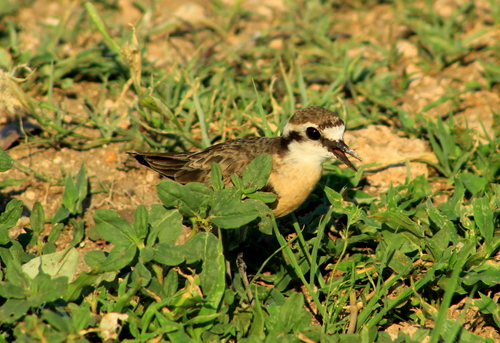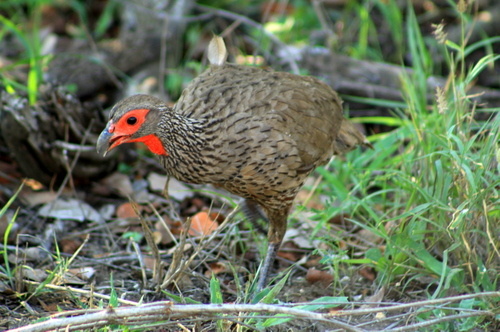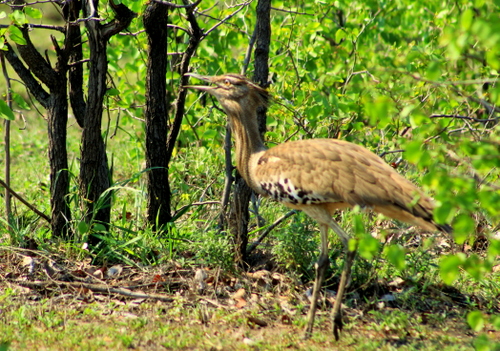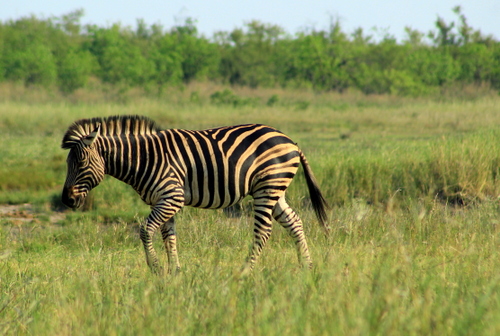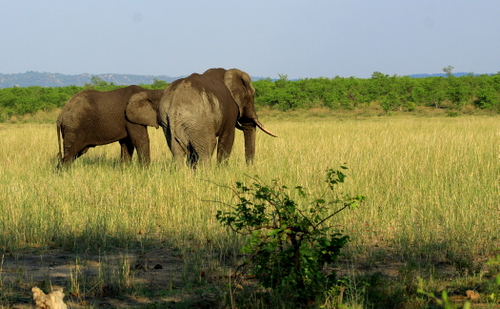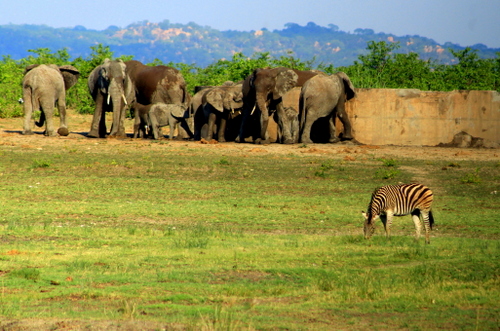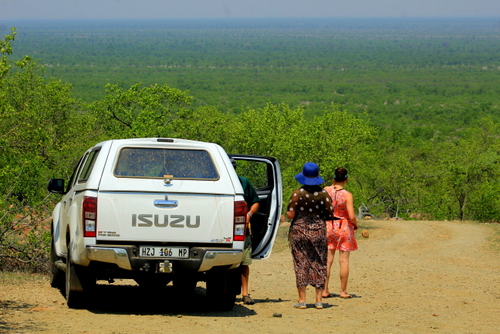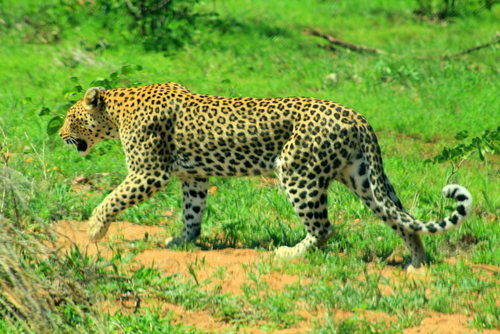I stood on the deck of the lodge watching the broken white water as it fought and funnelled its way through a series of rapids and cataracts that had been cut into the cracked and fissured seams of rock below. At a point, to my left, its numerous strands converged into a single gushing torrent before plunging over a small waterfall into a narrow ravine and then meandering off towards the distant red cliffs.

The trellised patchwork of islands, sandbanks, spits, reed beds and rocky promontories immediately above it was alert with life. On one of the larger islands, a bloat of hippos lay stretched out, comatose, in the sand, lapping up the last warming rays of the sun. Just across the way, another, smaller group had marked out their separate slice of prime riverside real estate. Stately water buck, with their white rump and course grey hair, stood in small groups by the water’s edge scanning the bush for any hidden dangers before stepping gingerly down to drink. They had good reason to be cautious. Not far from where the one lot was, several huge basking crocodiles lay supine on the bank. In a nearby pool, I could just make out the long snout and dinosaur eyes of another as it floated, log-like, just below the surface.
As the sun sank lower, the hippo began to lift their dusty bulks and move, either to where there was grass to eat or by simply lumbering into the fast-flowing river beside them, snorting up clouds of bubbles as they did. Directly beneath me, several large elephants, their calves in tow, ploughed their way through the reed beds, leaving behind a ruined bog of mud and crushed vegetation. A pair of quarrelsome Egyptian Geese shouted rancorously about who knows what before flying off down the river to their nightly roosting spot.

On the far side of the river, the trees stretched away, seemingly forever, under an arch of empty blue sky. There were no buildings, no people, nothing to suggest that this landscape had ever been inhabited by anything but animals. There are tourists in the park, of course, plenty of them. Driving around under the supervision of the tour operators in especially converted game-viewing vehicles and decked out in their idea of appropriate bush wear, many of them look strangely ill at ease and out of place in this primordial landscape. Watching some of them earlier, as they gathered for an afternoon drive, I could not help but think of Joseph Conrad’s baffled ‘pilgrims’ in his dark tale about a boat trip up another mighty African river (the Congo) – Heart Darkness.
Raising my binoculars, I scanned upstream. In the far distance a herd of elephants, their thirst slaked, trekked in single file across the sand towards the surrounding woodlands. Led by the senior matriarch, they flowed along in a steady swaying motion, their large, sensitive, ears flapping gently, their trunks hanging slackly down. Despite their immense size, elephants can move surprisingly quietly, sometimes only the low rumble of their stomachs giving their presence away.

They moved with all the solemn dignity of a line of monks heading to evening vespers. I found it all deeply moving.
Indeed, if I didn’t know better, I would have sworn the whole scene had been deliberately conjured up by the park authorities just to show me why the river had been so named.
A major tributary of the Limpopo, the Olifants is one of the iconic Kruger rivers. Its camp, built on the steep shoulder of a hill just where the river abruptly bends, has, to my mind, the most breathtaking view in the entire park. I don’t normally get to stay in it because it doesn’t have a campsite where I can pitch my tent – which is as far as my limited travel budget normally allows – but this time I was doing it some style thanks to the kindness of other family members. I was enjoying the upgrade, to say nothing of the view.


I have always felt a strong affinity for rivers, especially African ones. In Conrad’s famous novella, the Congo River comes to symbolise the more evil aspects of man, as well the moral confusion its narrator, Marlow, experiences as he steams up it in search of the elusive Mr Kurz. For me, though, the river in front of me had far less sinister associations. As it twisted and turned and hammered its way through the hard, layered, rock of the Lebombo mountain range, it got me thinking about the passing of time.
The Olifants begins its journey somewhere up on the high plateau of Mpumalanga, drops down through the craggy peaks of northern Drakensberg and then snakes its way, serpent-like, across the great plain below. Along the way it faces challenges, difficulties and threats as it is forced to assess and choose options best suited to making progress. These periods of turbulence are followed by passages of calm and smooth going where it is able, quite literally, to go with the flow. Towards the end, it slows down to a point of torpor before dissipating into the Limpopo and then, finally, the sea. Having had to navigate some perilous waters of my own, I was only too aware of what point of that journey my life had reached. It made me a little uneasy – and all the more determined to make the most of this trip.
On another level, the Olifants River encapsulated everything I love about the Bushveld and this magnificent last refuge of large animals. Staring out over its shimmering pools, piles of driftwood and darkening shadows I, once again, found my imagination fired by its vast mysteries and remote beauties.

By now the sun had sunk beneath the horizon. With its departure, scores of bats came hurtling out from their roosts and headed out over the water, their bodies silhouetted black against the orange-red sky. On cue, the dark, falcon-like, form of a Bat Hawk came slashing through the sky in hot pursuit. A rare resident, whose distribution in South Africa is confined mostly to Kruger and northern Kwa-Zulu Natal this secretive bird, which roosts by day, is not often seen.
It was obviously not the only creature out on the hunt that night. As I took another sip of beer, I heard a scuffling sound from an area of dry grass just outside the electrified fence. Leaning over the guard rail, I caught a glimpse of a black-backed, short-legged, busy-looking, animal scuttling quickly on the ground. It was a Honey Badger, notorious for its ferocity if cornered, whose coarse hair and thick skin helps protect it from bee stings.
Sitting in the dark blue light, with Venus glittering brightly just above the horizon, I could imagine the countryside below us alive with similar hungry eyes – lion, leopard, hyena, wild dog, jackal – while shadowy herds, sensing their not-so-friendly intentions, stood in the darkness, frozen with fear.
After dinner. which we ate outside under the stars, I lay in bed listening to the comforting sound of the river below. It felt wonderful to be enveloped once more in these familiar surroundings. I looked forward to the next days’ explorations, wondering what they would bring?
Olifants lies within a transition zone between three ecosystems. It is here that the open savannah country, typical of the Satara area, gives way to Mopani, by far the most dominant tree of the northern section of the park. It also marks the beginning of baobab country. To the east stretches the Lebombo mountain chain– which starts in KZN and runs through the entire length of Swaziland before entering the park. Studded with rocks, thorns, bushwillows and candelabra-like euphorbia its forms the spine of the park.

The next day, we got up before the sun and headed along the road that leads past VonWeilligh’s Baobab stopping off at the viewpoint along the way. We arrived just in time to see the sun rise over the same impressive cliffs that I had admired through my binoculars the evening before.
I usually travel to Kruger at the height of summer – to catch the returning migrants – when the temperatures regularly rise into the forties, so the chill came as a surprise. Pale gold in the early morning light, we could sense the countryside around us coming to life. As the sky lightened in the east, a whole chorus of birds began twittering in the trees, as if paying homage to the dawn of a new day. Doves pumped their throats in vigorous coooi-ing (“How’s father, how’s father?!”). Fork-tailed Drongoes performed acrobatics in the cold air. Spurfowl scolded. Waggle-tailed impala scampered about, no doubt relieved to have survived another night. Giraffes arched their necks to nibble on tree tops. In the grass beside the road, I saw a Red-crested Korhaan still bunched up in a round, feathery ball because of the cold.

A lone Spotted Hyena came loping up the road. It stopped for a few moments directly in front of the car and fixed its cadaverous eyes on us like it was some escapee from the underworld with an unusual tale to tell. Then it made a small diversion, trotted around the side of the vehicle, gave one last look back and disappeared back into the shadowy world it had emerged from.

We moved on, searching with hopeful eyes for more exciting sightings. The highlight of our drive up from Malelane had been spotting a leopard (actually, someone else had spotted it, we had just joined the general vehicular mayhem and excitement created by the sighting). On the move, a leopard can radiate menace and deadly intention but sprawled out, fast asleep in the fork of a gnarled old tree, this one looked as harmless as any domestic tabby cat. I could almost imagine it purring with contentment if I had climbed up the tree and stroked it.

Now it was our turn for lions. This time we had them all to ourselves, without all the jostling-for-position vehicles blocking our view. There are few more sights in nature more awe-inspiring than a pride of lions returning from a night hunt and this lot really was impressive. The large, shaggy-maned, male crossed the road ahead of us, its walk low-slung and easy. It appeared completely indifferent to our presence, not even casting a side-long glance in our direction as it disappeared into the trees on the other side. A young lioness was more curious, coming right up to the edge of the car, the gold cat’s sun-flecked eyes shimmering with hidden lights as she stared up at me. Sitting next to my open window, worrying about the possibility she saw me as a potential meal, I suddenly became aware of just how close she was.


We drove on. Two round-haunched zebra stood rock-still on the crest of the road before us, considering their options before moving on towards the distant horizon. I wondered if the bush telegraph had told them about the lion…

Later, we came across a family of hyenas who had taken up residence in a network of old burrows by the side of the road. Accustomed to cameras and faces in cars, they were not the slightest put out by our proximity to their lair. In the background, lay the mother, fast asleep in the shade of a mopani tree. As we pulled to a stop, one of her cubs stuck its head out of its hole, eyed us quizzically and, obviously decided to extend us some hospitality, for it came frolicking towards us. The curious youngster gave our car a quick, 360degree inspection, sniffing here and there – my brother-in-law had a few anxious moments because he thought it was about to bite a chunk out of the back tyre of his brand new car – and then went back to its hole, plonking itself alongside the entrance and going to sleep too, its social obligations for the day completed.


I felt well pleased. It is always an event to see two of the Big Cats in so many days and has a bunch of hyenas thrown in as a bonus, a small triumph scored. Now, I just needed Wild Dog but – alas – on that score, I would once again be disappointed…
Over the next few days, though, we continued to traverse this landscape with the same sense of wonder, immersing ourselves in the daily rhythms of the animals.
We travelled south towards Satara, via Balule and the Nwanetsi river route, where the country opens up into grassland populated by companies of zebra and wildebeest. There were more elephants, trundling along in the yellow light of dawn. As always, the matriarch led the way knowing, from years of experience, where the best grazing lay. At a small drift, we came upon a quaint Little and Large scene – an elephant siphoning up voluminous amounts of liquid from the same spot a mother spurfowl and her chicks were sipping much more delicately. The small birds seemed completely unfazed by the size and proximity of their drinking companion.

Besides the big rivers – Crocodile, Shingwedzi, Olifants, Letaba, Luvuvhu, the Limpopo – many smaller rivulets run through Kruger although most remain dry outside the rainy season. It is always worth stopping at these quieter, more secluded, roadside pools as you never know what you might find skulking around the margins. Often they provide a home for herons, egrets, storks and stilts, waders, Three-banded Plovers, as well as the shy Black Crake with its bright red beak and legs. Amongst the reeds and greenery, you may be lucky enough to catch a glimpse of the brilliant orange and sapphire plumage of the Malachite Kingfisher just before it plunges into the water. Brighter than any illustration could be, this beautiful little bird is but one of the many species of kingfisher that occur in the park.




Changing direction, the next day, we travelled north along the Letaba River to the camp bearing that name. Up until that point we had hardly seen another soul but that all changed when we got there and ran slap-bang into the very thing I had been seeking to avoid because it rather undercuts the whole wilderness experience – a seething mass of humanity. Most of them were either on their cellphones, guzzling cool drinks with exuberant lust or wolfing down junk food. Even Kruger, it seems, is not safe from the consumer society and with the ever-increasing volumes of tourist traffic overcrowding could become a problem.
But we had better things to occupy our minds with. The next day we cut westwards following the meandering path of the Timbabvati River, not too far from the area famed for its white lions. We didn’t see them but we did see two standard-model female lions lying in the shade by the river. They too ignored us, just another carload of gaping sight-seers. Several kilometres on we also came across a handsome old boy lying prostrate in the golden grass. He blended in so well, you could barely make him out.
Impalas are plentiful in this part of the park, so the lion’s presence hardly came as a surprise. More easily overlooked and solitary in habits were the steenbok. Graceful, soft-furred little creatures, their diminutive size makes them look especially vulnerable but they somehow survive in this harsh environment. Like other buck, they live a life of constant chase and evasion.


Then there were the birds. With over 500 species recorded, Kruger is a birder heaven. It is also a great place for raptors. I dutifully ticked off Martial Eagle, African Hawk Eagle, Fish Eagle, Tawny Eagle, and Brown Snake Eagle. The open grasslands in the central regions of the park are also good places to see Secretary Birds (actually an eagle with very long legs), Kori Bustard (the heaviest flying bird in the world), and the lugubrious Southern Ground Hornbill (we were lucky enough to have three separate sightings. They are now listed as Threatened in many parts of their range).


Heading homeward at the end of our trip, we came across another solitary leopard striding purposefully through the grass by the side of the road. Unlike the one we had seen coming in, it looked neither relaxed nor friendly. Openly disdainful of our presence, it didn’t bother to look back as I clicked away on my camera.

A bit further on, we chanced upon a wake of vultures sitting hunched up on the canopies of the surrounding trees, still digesting the carrion from a nearby lion kill. Because of their rather unsavoury habit of sticking their long, naked necks deep into the putrescence, vultures don’t enjoy the most favourable of reputations. I must confess, however, to having a peculiar fondness for these greedy, squabbling, big-beaked, gimpy-eyed, angry-looking, scavenger birds. As a cartoonist, I find them wonderful to draw. Amongst this group – made up mostly of the White-backed – I was pleased to see a White-headed Vulture, now very rare outside the major game reserves.


Our encounter with vultures did not end there. My brother-in-law had told me of a place, further south, where flocks of vultures like to regularly gather on the banks of a river for a daily dust bath. Sure enough, when we drew up on the bridge, there they all were, just downstream, dancing around one another in cantering hops, their enormous wings outstretched, their white back marking clearly displayed. They looked like priesthood initiates participating in some archaic, secretive, sacrificial ritual.

Why they chose this particular spot to perform their ceremonial ablutions is unclear. I was still pondering the mystery of this when we crossed over the Crocodile River (also aptly named) and exited the park. Suddenly, we were no longer in the heart of the wilderness but buzzing along a two-lane highway crammed solid with huge trucks, speeding cars and maniacal drivers.
Caught up in the juggernaut, reality began to seep back in. My escape from civilisation was over. Now, I was headed back to a world of responsibilities and commitments; to say nothing of difficult people, dysfunctional municipalities, corrupt and inept politicians, crumbling infrastructure and load shedding, all of which it is my job, as a cartoonist, to dutifully portray and comment on. I had to fight my every instinct which was to turn around and flee back to the far more agreeable company of the vultures…
GALLERY
Birds:
















Other scenes:

























